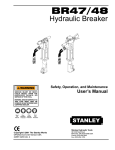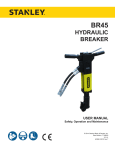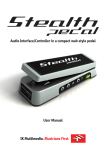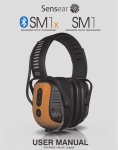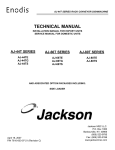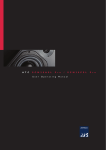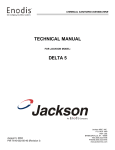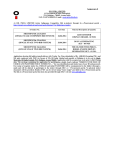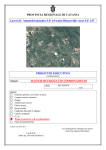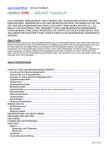Download BR45 Service Manual,ver2.cdr
Transcript
BR45 Hydraulic Breaker Safety, Operation, and Maintenance SERIOUS INJURY OR DEATH COULD RESULT FROM THE I M P R O P E R R E PA I R O R SERVICE OF THIS TOOL. Service Manual REPAIRS AND/OR SERVICE TO THIS TOOL MUST ONLY BE DONE BY AN AUTHORIZED AND CERTIFIED DEALER. Read The Manual Wear Wear Hearing Breathing Protection Protection Wear Eye Protection STANLEY Stanley Hydraulic Tools Copyright c 2004 The Stanley Works OPS/Service & CE Version USA 07650 02/04 Ver. 2 3810 SE Naef Road Milwaukie, OR 97267-5698 USA Phone: (503) 659-5660 Fax: (503) 652-1780 Table of Contents BR45 Hydraulic Breaker Servicing The BR45 Hydraulic Breaker: This manual contains Safety, Operation, Service and Troubleshooting information. Stanley Hydraulic Tools recommends that servicing of hydraulic tools, other than routine maintenance, must be performed by an authorized and certified dealer. Please read the WARNING on the cover and the SAFETY warning below. Contents 1 Certificate of Conformity (BR45) 2 Specifications 3 General Safety Instructions 4,5 Tools Decals and Tags 6 Hydraulic Hose Requirements 7 HTMA Requirements 8 Equipment Protection and Care 9 10 Operating Instructions Copyright c 2004 The Stanley Works All rights reserved. Under copyright law, this document may not be copied in whole or in part without the prior written consent of The Stanley Works. This exception does not permit copies to be made for others, whether or not sold. Under the law, copying includes translating into another language, format or medium. This copyright notice must appear on any permitted copies. Service 11-13 Troubleshooting 14,15 Maintenance 16,17 Parts Illustration 19,21 Parts List 18,20 Accessories 22 Warranty 23 SAFETY FIRST It is the responsibility of the operator and service technician to read rules and instructions for safe and proper operation and maintenance. A cautious worker using common sense is the greatest safety device. 1 CERTIFICATE OF CONFORMITY Hydraulic Tools I, the undersigned: Winterling, David Surname and First names Hereby certify that the construction plant or equipment specified hereunder: 1. Manufacturer: Stanley Hydraulic Tools, 3810 SE Naef Road, Milwaukie, Oregon USA 2. Representative in the Union: Stanley Svenska AB, Box 9054, 400 92 GÖteborg, SWEDEN 3. Category: Hydraulic Hand Held Concrete Breaker 4. Make: Stanley Hydraulic Tools 5. Type: BR4514801 / BR4516201 / BR4516801 / BR4512201E 6. Type serial number of equipment: ALL 7. Year of Manufacture: Beginning 2002 Has been manufactured in conformity with the provisions of the Machinery Directive 98/37/EC Harmonized standard applied: EN 792-4 We also declare that it meets the specification of Noise Directive 2000/14/EC, measured in accordance to the Conformity Evaluation Method set out in Annex VI para. 5 and evaluated during production as in Annex VI para. 6, 2nd procedure. 8. Noise related value: 23 kg 9. Measured sound power on equipment representative of this type: 106 LwA 10. Guaranteed sound power level for this equipment: 109 LwA 11. Notified body for EC directive 2000/14/EC: 0404 SMP Svensk Maskinprovning AB Fyrisborgsgatan 3 754 50 Uppsala, SWEDEN 12. Special Provisions: None Issued at Stanley Hydraulic Tools, Milwaukie, Oregon USA Date: 8/21/02 Signature: Position: Engineering Manager P/N 52571 Rev.1, 8/21/02 2 Specifications Pressure Range............1500- 2000 psi/105-140 bar FlowRange (HTMA-II) 7-9gpm/26-34lpm OverallLength.....(T-Handle23.5/25.5in.60/65cm. ......(Anti-VibrationHandle)25.2/28.25in.65/72cm OptimumFlow..................................8gpm / 30 lpm OverallWidth-@handles..(T-Handle)14in./35cm .....................(Anti-VibrationHandle)17.5/44.5cm Maximum BackPressure.................250 Psi/17bar Max.FluidTemp...................................140°F/60°C Couplers.................................... HTMA Flush Face SystemType......................OpenOrClosedCenter PerNFPAT3.20.15/ISO16028 Connect Size & Type-3/8 in. MalePipeHoseEnds HoseWhips.........................................................Yes Weight......................(T-Handle) 45/48 lbs.20/21kg .............(Anti-VibrationHandle)48/51lbs.22/23 kg PortSize.............................................SAE8O-ring SoundPowerLevel....................................109dBA VibrationLevel.....................(T-Handle)13.5m/sec² .........................(Anti-VibrationHandle)10.1m/sec² NOTE Weights, dimensionsandoperatingspecificationslistedare subject to changewithout notice.Wherespecificationsarecriticalto your application, please consult the factory. 3 SAFETY SYMBOLS Safety symbols and signal words, as shown below, are used to emphasize all operator, maintenance and repair actions which, if not strictly followed, could result in a life-threatening situation, bodily injury or damage to equipment. This is the safety alert symbol. It is used to alert you to potential personal injury hazards. Obey all safety messages that follow this symbol to avoid possible injury or death. This safety alert and signal word indicate an imminently hazardous situation which, if not avoided, will result in death or serious injury. This safety alert and signal word indicate a potentially hazardous situation which, if not avoided, could result in death or serious injury. This safety alert and signal word indicate a potentially hazardous situation which, if not avoided, may result in minor or moderate injury. This signal word indicates a potentially hazardous situation which, if not avoided, may result in property damage. This signal word indicates a situation which, if not avoided, will result in damage to the equipment. This signal word indicates a situation which, if not avoided, may result in damage to the equipment. Always observe safety symbols. They are included for your safety and for the protection of the tool. LOCAL SAFETY REGULATIONS Enter any local safety regulations here. Keep these instructions in an area accessible to the operator and maintenance personnel. 4 General Safety Instructions Tool operators and maintenance personnel must always comply with the safety precautions given in this manual and on the stickers and tags attached to the tool and hose. These safety precautions are given for your safety. Review them carefully before operating the tool and before performing general maintenance or repairs. Supervising personnel should develop additional precautions relating to the specific work area and local safety regulations. If so, place the added precautions in the space provided on page 4. This tool will provide safe and dependable service if operated in accordance with the instructions given in this manual. Read and understand this manual and any stickers and tags attached to the tool and hoses before operation. Failure to do so could result in personal injury or equipment damage. A Operator must start in a work area without bystanders. Flying debris can cause serious injury. The operator must be familiar with all prohibited work areas such as excessive slopes and dangerous terrain conditions. A Establish a training program for all operators to ensure safe operations. A Do not operate the tool unless thoroughly trained or under the supervision of an instructor. A Always wear safety equipment such as goggles, head protection, and safety shoes at all times when operating the tool. A Do not inspect or clean the tool while the hydraulic power source is connected. Accidental engagement of the tool can cause serious injury. A Do not operate this tool without first reading the Operating Instructions. A Do not install or remove Parts on this tool while the hydraulic power source is connected. Accidental engagement of the tool can cause serious injury. A Never operate the tool if you cannot be sure that underground utilities are not present. Underground electrical utilities present an electrocution hazard. Underground gas utilities present an explosion hazard. Other underground utilities may present other hazards. A Do not wear loose fitting clothing when operating the tool. Loose fitting clothing can get entangled with the tool and cause serious injury. A Supply hoses must have a minimum working pressure rating of 2500 psi/175 bar. A Be sure all hose connections are tight. A The hydraulic circuit control valve must be in the “OFF” position when coupling or uncoupling the tool. Wipe all couplers clean before connecting. Failure to do so may result in damage to the quick couplers and cause overheating. Use only lint-free cloths. A Do not operate the tool at oil temperatures above 140° F/60° C. Operation at higher oil temperatures can cause operator discomfort and may cause damage to the tool. A Do not operate a damaged, improperly adjusted, or incompletely assembled tool. A To avoid personal injury or equipment damage, all tool repair, maintenance and service must only be performed by authorized and properly trained personnel. A Do not exceed the rated limits of the tool or use the tool for applications beyond its design capacity. A Always keep critical tool markings, such as labels and warning stickers legible. A Always replace parts with replacement parts recommended by Stanley Hydraulic Tools. A Check fastener tightness often and before each use daily. 5 Tool Decals & Tags A Name Tag Sticker is attached to the tool. Never exceed the flow and pressure levels specified on this sticker. The information listed on the Name Tag sticker must be legible at all times. Replace this sticker if it becomes worn or damaged. A replacement is available from your local Stanley distributor. 28322 11207 CE Label Circuit “D” Label CE Models Only CE Models Only 58603 Guaranteed Sound Power Level Sticker CE Models Only 28379 Stanley Label CE Models Only 07487 Name Tag 6" CE Models Only ✘ 28376 Stanley Label CE Models Only 28409 Composite Safety Label 11208 Hex Shank Length Label ✔ 6¼" DANGER DANGER 1. FA I LU R E T O U S E H Y D RAU L I C H O S E L A B E L E D A N D CERTI-FIED AS NON-CONDUCTIVE WHEN USING HYDRAULIC TOOLS ON OR NEAR ELECTRICAL LINES MAY RESULT IN DEATH OR SERIOUS INJURY. BEFORE USING HOSE LABELED AND CERTIFIED AS NON- CONDUCTIVE ON OR NEAR ELECTRIC LINES. BE SURE THE HOSE IS MAINTAINED AS NON- CONDUCTIVE . THE HOSE SHOULD BE REGULARLY TESTED FOR ELECTRIC CURRENT LEAKAGE IN ACCORDANCE WITH YOUR SAFETY DEPARTMENT INSTRUCTIONS. 2. A H Y D R A U L I C L E A K O R B U R S T M AY C A U S E O I L INJECTION INTO THE BODY OR CAUSE OTHER SEVERE PERSONAL INJURY. A. D O N O T E X C E E D S P E C I F I E D F L O W A N D P R E S S U R E F O R T H I S T O O L . E X C E S S F LO W O R PRESSURE MAY CAUSE A LEAK OR BURST. B. D O N O T E X C E E D R AT E D W O R K I N G P R E S S U R E OF HYDRAULIC HOSE USED WITH THIS TOOL. E X C E S S P R E S S U R E M AY C A U S E A L E A K O R BURST. C. C H E C K T O O L , H O S E , C O U P L E R S & C O N N E C T O R S D A I LY F O R LEAKS. DO NOT FEEL FOR LEAKS WITH Y O U R H A N D S . C O N TA C T W I T H A L E A K M AY RESULT IN SEVERE PERSONAL INJURY. The SAFETY TAG, P/N 15875, shown at right, smaller than actual size, is attached to the tool when shipped from the factory. Read and understand the safety instructions listed on this tag before removal. We suggest you retain this tag and attach it to the tool when not in use. D. DO NOT LIFT OR CARRY TOOL BY THE HOSES. DO NOT ABUSE HOSE. DO NOT USE KINKED, TORN OR DAMAGED HOSES. 3. M A K E S U R E H Y D R A U L I C H O S E S A R E P R O P E R LY CONN-ECTED TO THE TOOL BEFORE PRESSURIZING S Y S T E M . S Y S T E M P R E S S U R E H O S E M U S T A LWAY S B E C O N N E C T E D T O T O O L “ I N ” P O R T. S Y S T E M R E T U R N H O S E M U S T A LW AY S B E C O N N E C T E D AT T O O L “ O U T ” P O RT. R E V E R S I N G C O N N E C T I O N S M AY C A U S E R E V E R S E T O O L O P E R AT I O N W H I C H C A N CAUSE SEVERE PERSONAL INJURY. 4. D O N O T C O N N E C T C L O S E D - C E N T E R T O O L S T O O P E N - C E N T E R H Y D R A U L I C S Y S T E M S . T H I S M AY C A U S E E X T R E M E S Y S T E M H E AT A N D / O R S E V E R E PERSONAL INJURY. DO NOT CONNECT OPEN-CENTER TOOLS TO C LO S E D - C E N T E R HYDRAULIC SYSTEMS. THIS MAY RESULT IN LOSS OF OTHER HYDRAULIC FUNCTIONS POWERED BY THE SAME SYSTEM AND/OR SEVERE PERSONAL INJURY. 5. B Y S TA N D E R S M A Y B E I N J U R E D I N Y O U R W O R K A R E A . K E E P BY S TA N D E R S C L E A R O F YO U R W O R K AREA. 6. WEAR HEARING, EYE, FOOT, HAND AND HEAD PROTECTION. 7. TO AVOID PERSONAL INJURY OR EQUIPMENT DAMAGE, ALL TOOL REPAIR, MAINTENANCE AND SERVICE MUST BE PERFORMED BY AUTHORIZED A N D P R O P E R LY TRAINED PERSONNEL. IMPORTANT IMPORTANT READ OPERATION MANUAL AND SAFETY INSTRUCTIONS FOR THIS TOOL BEFORE USING IT. READ OPERATION MANUAL AND SAFETY INSTRUCTIONS FOR THIS TOOL BEFORE USING IT. USE ONLY PARTS AND REPAIR PROCEDURES APPROVED BY STANLEY AND DESCRIBED IN THE OPERATION MANUAL. USE ONLY PARTS AND REPAIR PROCEDURES APPROVED BY STANLEY AND DESCRIBED IN THE OPERATION MANUAL. TAG TO BE REMOVED ONLY BY TOOL OPERATOR. (517) SEE OTHER SIDE 15875 TAG TO BE REMOVED ONLY BY TOOL OPERATOR. (517) SEE OTHER SIDE 15875 6 Hydraulic Hose Requirements HOSE TYPES Hydraulic hose types authorized for use with Stanley Hydraulic Tools are as follows: Certified non-conductive Wire-braided (conductive) Fabric-braided (not certified or labeled non-conductive) Hose listed above is the only hose authorized for use near electrical conductors. Hoses and listed above are conductive and must never be near electrical conductors. HOSE SAFETY TAGS To help ensure your safety, the following DANGER tags are attached to all hoses purchased from Stanley Hydraulic Tools. DO NOT REMOVE THESE TAGS. If the information in a tag is illegible because of wear or damage, replace the tag immediately. A new tag may be obtained from your Stanley Distributor. This Tag attached to “Certified Non-Conductive” hose. DANGER 1. FAILURE TO USE HYDRAULIC HOSE LABELED AND CERTIFIED AS NON-CONDUCTIVE WHEN USING HYDRAULIC TOOLS ON OR NEAR ELECTRIC LINES MAY RESULT IN DEATH OR SERIOUS INJURY. FOR PROPER AND SAFE OPERATION, MAKE SURE THAT YOU HAVE BEEN PROPERLY TRAINED IN CORRECT PROCEDURES REQUIRED FOR WORK ON OR AROUND ELECTRIC LINES. 2. BEFORE USING HYDRAULIC HOSE LABELED AND CERTIFIED AS NON-CONDUCTIVE ON OR NEAR ELECTRIC LINES, WIPE THE ENTIRE LENGTH OF THE HOSE AND FITTINGS WITH A CLEAN, DRY, ABSORBENT CLOTH TO REMOVE DIRT AND MOISTURE AND TEST HOSE FOR MAXIMUM ALLOWABLE CURRENT LEAKAGE IN ACCORDANCE WITH SAFETY DEPARTMENT INSTRUCTIONS. DANGER 4. HANDLE AND ROUTE HOSE CAREFULLY TO AVOID KINKING, ABRASION, CUTTING OR CONTACT WITH HIGH TEMPERATURE SURFACES. DO NOT USE IF KINKED. DO NOT USE HOSE TO PULL OR LIFT TOOLS, POWER UNITS, ETC. 5. CHECK ENTIRE HOSE FOR CUTS, CRACKS, LEAKS, ABRASIONS, BULGES OR DAMAGE TO COUPLINGS. IF ANY OF THESE CONDITIONS EXIST, REPLACE THE HOSE IMMEDIATELY. NEVER USE TAPE OR ANY DEVICE TO ATTEMPT TO MEND THE HOSE. 6. AFTER EACH USE, STORE IN A CLEAN, DRY AREA. 3. DO NOT EXCEED HOSE WORKING PRESSURE OR ABUSE HOSE. IMPROPER USE OR HANDLING OF HOSE COULD RESULT IN BURST OR OTHER HOSE FAILURE. KEEP HOSE AS FAR AWAY AS POSSIBLE FROM BODY AND DO NOT PERMIT DIRECT CONTACT DURING USE. CONTACT AT THE BURST CAN CAUSE BODILY INJECTION AND SEVERE PERSONAL INJURY. SEE OTHER SIDE SEE OTHER SIDE Side 1 Side 2 DO NOT REMOVE THIS TAG DO NOT REMOVE THIS TAG (shown smaller than actual size) p/n 27987 This Tag attached to “Conductive” hose. DANGER DANGER 1. DO NOT USE THIS HYDRAULIC HOSE ON OR NEAR ELECTRIC LINES. THIS HOSE IS NOT LABELED OR CERTIFIED AS NON-CONDUCTIVE. USING THIS HOSE ON OR NEAR ELECTRIC LINES MAY RESULT IN DEATH OR SERIOUS INJURY. 5. CHECK ENTIRE HOSE FOR CUTS, CRACKS, LEAKS, ABRASIONS, BULGES OR DAMAGE TO COUPLINGS. IF ANY OF THESE CONDITIONS EXIST, REPLACE THE HOSE IMMEDIATELY. NEVER USE TAPE OR ANY DEVICE TO ATTEMPT TO MEND THE HOSE. 2. FOR PROPER AND SAFE OPERATION, MAKE SURE THAT YOU HAVE BEEN PROPERLY TRAINED IN CORRECT PROCEDURES REQUIRED FOR WORK ON OR AROUND ELECTRIC LINES. 6. AFTER EACH USE, STORE IN A CLEAN, DRY AREA. 3. DO NOT EXCEED HOSE WORKING PRESSURE OR ABUSE HOSE. IMPROPER USE OR HANDLING OF HOSE COULD RESULT IN BURST OR OTHER HOSE FAILURE. KEEP HOSE AS FAR AWAY AS POSSIBLE FROM BODY AND DO NOT PERMIT CONTACT DURING USE. CONTACT AT THE BURST CAN CAUSE BODILY INJECTION AND SEVERE PERSONAL INJURY. 4. HANDLE AND ROUTE HOSE CAREFULLY TO AVOID KINKING, ABRASION, CUTTING OR CONTACT WITH HIGH TEMPERATURE SURFACES. DO NOT USE IF KINKED. DO NOT USE HOSE TO PULL OR LIFT TOOLS, POWER UNITS, ETC. SEE OTHER SIDE SEE OTHER SIDE Side 1 Side 2 DO NOT REMOVE THIS TAG DO NOT REMOVE THIS TAG (shown smaller than actual size) p/n 29144 HOSE PRESSURE RATING The rated working pressure of the hydraulic hose must be equal to or higher than the relief valve setting on the hydraulic system. 7 These are general hydraulic system requirements. See tool specifications page for tool specific requirements. HTMA Requirements Hydraulic System Requirements Tool Category: 20Lpm at 138bar BHTMA CATEGORY 30Lpm at 138bar BHTMA CATEGORY Type I Type RR Type III Type II Flow rate Tool Operating Pressure 4-6 GPM (15-23 7-9 GPM (26-34 11-13 GPM lpm) Lpm) lpm) (at the power supply outlet) 2000 psi (138 bar) 2000 psi (138 bar) 2000 psi (138 bar) 2000 psi (138 bar) System relief valve setting (at the power supply outlet) Maximum back pressure (at tool end of the return hose) Measured at a max. fluid viscosity of: (at min. operating temperature) Temperature Sufficient heat rejection capacity to limit max. fluid temperature to: (42-49 9-10.5 GPM (34-40 lpm) 2100-2250 2100-2250 2100-2250 2200-2300 (145-155 bar) (145-155 bar) (145-155 bar) (152-159 bar) 250 psi 250 psi 250 psi 250 psi (17 bar) (17 bar) (17 bar) (17 bar) 400 SSU 400 SSU 400 SSU 400 SSU (82 centistokes) (82 centistokes) (82 centistokes) (82 centistokes) 140° F (60° C) 140° F (60° C) 140° F (60° C) 140° F (60° C) 3 hp (2.24 kW) 40° F (22° C) 5 hp (3.73 kW) 40° F (22° C) 7 hp (5.22 kW) 40° F (22° C) 6 hp (4.5 kW) 40° F (22° C) (at max. expected ambient temperature) Min. cooling capacity at a temperature difference of between ambient and fluid temps NOTE: Do not operate the tool at oil temperatures above 140 ° F (60° C). Operation at higher temperatures can cause operator discomfort at the tool. Filter Min. full-flow filtration sized for flow of at least: 25 microns 25 microns 25 microns 30 GPM (114 lpm) 30 GPM (114 lpm) 30 GPM (114 lpm) 25 microns 30 GPM (114 lpm) (For cold temp. startup and max. dirt-holding capacity) Hydraulic fluid Petroleum based (premium grade, anti-wear, non-conductive) Viscosity (at min. and max. operating temps) 100-400 SSU* 100-400 SSU* 100-400 SSU* 100-400 SSU* (20-82 centistokes) (20-82 centistokes) (20-82 centistokes) (20-82 centistokes) NOTE: When choosing hydraulic fluid, the expected oil temperature extremes that will be experienced in service determine the most suitable temperature viscosity characteristics. Hydraulic fluids with a viscosity index over 140 will meet the requirements over a wide range of operating temperatures. *SSU = Saybolt Seconds Universal NOTE: These are general hydraulic system requirements. See tool Specification page for tool specific requirements. 8 Equipment Protection and Care In addition to the Safety Precautions found in this manual, observe the following for equipment protection and care. • Make sure all couplers are wiped clean before connection. • The hydraulic circuit control valve must be in the “OFF” position when coupling or uncoupling hydraulic tools. Failure to do so may result in damage to the quick couples and cause overheating of the hydraulic system. • Always store the tool in a clean dry space, safe from damage or pilferage. • Make sure the circuit PRESSURE hose (with male quick disconnect) is connected to the “IN” port. The circuit RETURN hose (with female quick disconnect) is connected to the opposite port. Do not reverse circuit flow. This can cause damage to internal seals. • Always replace hoses, couplings and other parts with replacement parts recommended by Stanley Hydraulic Tools. Supply hoses must have a minimum working pressure rating of 2500 psi/172 bar. • Do not exceed the rated flow (see Specifications page) in this manual for correct flow rate and model number. Rapid failure of the internal seals may result. • Always keep critical tool markings, such as warning stickers and tags legible. • Do not force a small breaker to do the job of a large breaker. • Keep tool bit sharp for maximum breaker performance. Make sure that tool bits are not chipped or rounded on the striking end. • Never operate a breaker without a tool bit or without holding it against the work surface. This puts excessive strain on the breaker foot. • Tool repair should be performed by experienced personnel only. • Make certain that the recommended relief valves are installed in the pressure side of the system. • Do not use the tool for applications for which it was not intended. 9 Operating Instructions The recommended hose size is .500 inch/12 mm I.D. up to 50 ft/15 m long and .625 inch/16 mm I.D. minimum up to 100 ft/30 m. Pre-Operation Procedures Check Power Source 1. Using a calibrated flowmeter and pressure gauge, check that the hydraulic power source develops a flow of 7-9 gpm/26-34 lpm at 1500/2000 psi/105140 bar. 5-6 gpm /18-22 lpm at 1500-2000 psi /105-140 bar. 2. Make certain the hydraulic power source is equipped with a relief valve set to open at 2250 psi/155 bar maximum. Install Tool Bit 1. Rotate the latch on the breaker foot downward (pointing away from the tool). 2. Insert the tool bit into the foot and pull the latch up to lock the tool bit in place. Connect Hoses 1. Wipe all hose couplers with a clean, lint-free cloth before making connections. 2. Connect the hoses from the hydraulic power source to the tool fittings or quick disconnects. It is a good practice to connect return hoses first and disconnect them last to minimize or avoid trapped pressure within the tool. 3. Observe flow indicators stamped on hose couplers to ensure that fluid flow is in the proper direction. The female coupler on the tool hose is the inlet coupler. 4. Move the hydraulic circuit control valve to the ON position to operate the tool. NOTE: If uncoupled hoses are left in the sun, pressure increase within the hoses may make them difficult to connect. When possible, connect the free ends of the hoses together. 3. Place the bit firmly on the surface to be broken. 4. Squeeze the trigger to start the breaker. Adequate down pressure is very important. When the tool bit breaks through the obstruction or becomes bound, release the trigger and reposition the tool bit. NOTE: Partially depressing the trigger allows the tool to run at slow speed. Slow-speed operation permits easier starting of the tool bit into the work surface. 5. To start, break an opening (hole) in the center of the surface. After making a hole, break portions of the material into the original opening. For best productivity, the breaking should be done around the original hole. The bite or width of the broken material will vary with the strength and thickness of the base material and the amount of any reinforcement wire or rebar. Harder material or more reinforcing wire or rebar will require taking smaller bites. To determine the most effective bite, start with 2 in. / 50 mm or smaller bites. Bites can then be gradually increased until the broken piece becomes too large, requiring increased time to break off the piece. Sticking of the tool bit occurs when too large a bite is being taken and the tool bit hammers into the material without the material fracturing. This causes the tool bit to become trapped in the surrounding material. Cold Weather Operation If the paving breaker is to be used during cold weather, preheat the hydraulic fluid at low engine speed. When using the normally recommended fluid, fluid temperature should be at or above 50° F/10° C (400 ssu/82 centistokes) before use. Damage to the hydraulic system or breaker can result from use with fluid that is too viscous or thick. Operation Procedures 1. Observe all safety precautions. 10 Service Instructions Good maintenance practice keeps the breaker on the job and increases its service life. The most important maintenance practice is to keep the hydraulic fluid clean at all times. Contaminated hydraulic fluid causes rapid wear and/or failure of internal parts. 4. Remove the four side rods. 5. Remove the top plate, then remove the handle pivot block with the two handles attached (Anti-vib model). On the (non-vib model) remove the handle. 6. If necessary, remove the two handles from the pivot block by removing the pivot screw securing Follow the procedure contained in the HYDRAULIC each handle (Anti-vibration models only). SYSTEM REQUIREMENTS section of the manual to ensure peak performance from the tool. 7. If necessary, the trigger and the lever can be removed from the trigger handle by driving out the Never disassemble the tool unless proper trouble spirol pin securing each part. shooting procedures have isolated the problem to an internal part. Disassemble it only to the extent 8. To service the foot assembly, proceed as follows: necessary to replace the defective part. KEEP CONTAMINANTS SUCH AS DIRT AND GRIT A. The latch, detent, spring and cone washers are AWAY FROM INTERNAL PARTS AT ALL TIMES. accessible when the latch bolt is removed (15/16-inch hex). Always determine and correct the cause of the problem prior to assembly. Further wear and tool Note: Before removing the hex bushing, note the failure can result if the original cause is not corrected. alignment of hex flats with latch bolt centerline (see figure 1) so that the new hex bushing is installed with the same alignment. Not all hex bushing flats align Breaker Disassembly with the latch bolt centerline, make sure you note the alignment before removing. Prior to Disassembly ! Clean exterior of tool. ! Obtain Seal Kit (Part Number 04595). Replace all seals exposed during disassembly. Note orientation of seals before removing them. Install new seals in the Figure 1. Hex Alignment with Latch Bolt same way. Disassembly 1. Secure the breaker in a bench vise with the “IN” and “OUT” ports up, clamping on the flow sleeve tube between the side rods. Soft vise jaws are recommended. 2. Remove the pigtail hose assemblies. 3. Remove the plug from the side of the handle pivot block (Anti-vibration models) or remove the plug from the top of the handle (Non-Anti-vibration models) and discharge the accumulator. WARNING Discharge accumulator. B. To service the hex bushing, the collar support must be removed. Press down on the collar support from the latch end to retract it from the retaining ring (a long bolt with large washers may be placed through the foot assembly to hold the collar support in the retracted position). Push a 3/16 inch/5mm punch through the side hole in the foot to dislodge the round wire retaining ring. This allows the ring to be removed with a hooked tool. Once the retaining ring has been removed, the retaining bolt can be loosened, or pressure removed, to remove the collar support and spring. WARNING The collar support is springloaded. Be sure to relax spring tension before removal. 11 C. If the wear rings on the collar support are worn or damaged, the rings and collar must be replaced as an assembly. D. Use a 1-3/8 inch/35 mm diameter steel rod 10 inches/25 cm long. Remove the latch and use the rod to push the hex bushing from the flanged end of the foot (toward the latch end). A 25 ton press is required. E. Place the new hex bushing, O. D. tapered end first into the foot bore and press into p l a c e . F. The cup seal and rod wiper should be removed with proper o-ring tools to avoid damage to the seal surfaces. (Note orientation above and below aluminum washer). 9. Remove the accumulator diaphragm and on-off valve spool from the accumulator valve block, taking care not to damage the valve stem. The spool, bushing and associated seals will come out as an assembly. 10. Remove the accumulator valve block from the flow sleeve by tapping on the underside of the valve block with a plastic or rubber hammer. Tap on alternate sides to ensure that the valve block comes out straight without binding. Turn the valve block upside down to remove the valve spring. 11. Remove the piston from the flow sleeve assembly. 12. Clamp the accumulator valve block in a bench vise with “IN” and “OUT” ports up. IMPORTANT C. Using an arbor press and an aluminum disc to protect the flow sleeve, push on the flow sleeve to remove the automatic valve body from the flow sleeve tube. IMPORTANT Use a rag in the bottom of the removal tube to protect the automatic valve body when it drops out. D. The automatic valve, four 1/4 x 1-1/2 inch /38mm long push pins (from the flow sleeve) and Two 3/16 x 1-1/4 inch/32mm long push pins from the automatic valve body will come out. E. To remove the flow sleeve from the flow sleeve tube, remove the automatic valve body and associated parts from within the flow sleeve removal tube, and continue pushing on the flow sleeve until it drops out. IMPORTANT Use a rag in the bottom of the removal tube to protect the flow sleeve. BREAKER ASSEMBLY PRIOR TO ASSEMBLY ! Clean all parts with a degreasing solvent. DGER Over tightening the vise can distort the block. 13. Remove the porting block from the accumulator valve block with a 3/8-16 thread slide hammer or Tamper Sleeve Tool (Part Number 01120). 14. To disassemble the flow sleeve and automatic valve body assembly, proceed as follows: A. Remove the piston if not previously removed. B. Place the flow sleeve assembly, automatic valve body down, on the Flow Sleeve Removal Tool (Part Number 04919) which in turn is placed on th Flow Sleeve Removal Tube (Part Number 04910). ! Obtain seal kit (Part Number 04595) so all seals exposed during disassembly can be replaced during assembly. ! Ensure that all seals that were exposed have been replaced with new parts. ! Apply clean grease or o-ring lubricant to all parts during reassembly. Note: For orientation of parts identified in the following procedures, see the parts list exploded view illustration at the back of this manual. 1. Check all parts for evidence of excessive wear, scoring, or obvious damage. Pay particular attention to seal and other running surfaces, looking for scratches or other signs of fluid contamination 12 caused defects. Dirty or water contaminated fluid can cause scratches on running component surfaces. 6. Install the piston, small end first, into flow sleeve assembly from the automatic valve body end. 2. Examine all exposed seals and o-rings for worn spots or damage caused by overheating or ingestion of contaminants. Although all exposed o-rings and seals must be replaced during assembly of the unit, this inspection should be performed to help identify related faulty components and the cause of an experienced or potential malfunction. 7. Install the porting block into the flow sleeve assembly with proper roll pin alignment. 3. All components exhibiting excessive wear or deep scratches can usually be touch up using emery cloth. Thoroughly clean all parts before assembly. 4. Apply clean grease or o-ring lubricant to all close fitting parts and seals during assembly. Assembly 1. Using and arbor press and an aluminum disc or Accumulator Cylinder Puller (Part Number 05640) to protect the flow sleeve, push the flow sleeve (with seven holes on its end facing up) into flow sleeve tube (o-ring groove up) until it is flush with the tube. Be sure to lubricate the entire bore of the flow sleeve tube prior to assembly. 2. Install the four 1/4 x 1-1/2 inch/38mm push pins, with ground face end up, in the flow sleeve. 3. Install the two 3/16 x 1-1/4 inch/32 mm push pins with the ground face end up, in the automatic valve body. Install the automatic valve, small diameter first into the automatic valve body. IMPORTANT The push pins must be installed such that the flat ground surfaces bear on the flange of the automatic valve. 4. Place the automatic valve body, with proper roll pin alignment and with the side holes up, on top of the flow sleeve. Allow the automatic valve to drop and pilot into the bore of the flow sleeve. 8. Place the accumulator valve block in a bench vise being careful not to over-tighten or distort the block. 9. Push the flow sleeve assembly into the accumulator valve block. It may be necessary to tap on the end of the flow sleeve tube with a rubber or plastic hammer. Be sure to tap on opposite sides to make sure that the assembly seats properly. 10. Remove assembly from the vise and clamp on the flow sleeve tube with “IN” and “OUT” ports facing up. 11. Slide the foot assembly over the piston and drive the foot into the flow sleeve tube by tapping the end of the foot with a plastic or rubber hammer. Align the foot latch with the trigger. 12. Replace (in this order) the spring, valve spool and bushing (with rod wiper facing out of the accumulator valve block) in valve spool bore. The bushing should project from the accumulator valve block approximately 0.200 inch/5mm. 13. Apply a light coating of WD40® lubricant to the accumulator diaphragm and install in the accumulator bore. 14. Place the handle pivot block (with handles attached on the accumulator valve block) then position the top plate on the pivot block. Lubricate the pivot screw O.D. And the rubbing surfaces of the handles with anti-seize compound. On models without anti-vibration handles place the handle on the accumulator valve block with the trigger side facing the latch on the breaker foot 15. Install the four side rods. Tighten the side rods in 15 ft lb/20 Nm increments to 60 ft lb/80 Nm. 16. Charge the accumulator (See the maintenance section of this manual for the charging procedure). 5. Use an aluminum disc or Accumulator Cylinder Puller (Part Number 05640) to protect parts, then push the automatic valve body into the flow sleeve tube until the valve body shoulder stops on the top of the flow sleeve tube. 13 Troubleshooting This section describes how to find and resolve problems users may experience. If a situation occurs that is not covered, call your Stanley Customer Service representative for assistance. WARNING Inspecting the tool or installing parts with the hydraulic hoses connected can result in severe personal injury or equipment damage. To prevent accidental startup, disconnect the hydraulic power before beginning any inspection or installation task. If symptoms of poor performance develop, the following chart can be used as a guide to correct the problem. When diagnosing faults in operation of the tool, always check that the hydraulic power source is supplying the correct hydraulic flow and pressure to the tool as listed in the table. Use a flowmeter known to be accurate. Check the flow with the hydraulic oil temperature at least 80° F/27° C. Symptom Tool does not run. Tool does not hit effectively. Possible Cause Solution Power unit not functioning. Check power source for proper flow and pressure (7-9 gpm/ 26-34 lpm, 2000 psi/ 140 bar). (5-6 gpm/18-22 lpm 2000 psi/140 bar) Couplers or hoses blocked. Remove restriction. Pressure and return line hoses reversed at ports. Be sure hoses are connected to their proper ports. Mechanical failure of piston or automatic valve. Power unit not functioning. Have inspected and repaired by an authorized dealer. Couplers or hoses blocked. Check power unit for proper flow and pressure (7-9 gpm/ 26-34 lpm, 2000 psi/ 140 bar). (5-6 gpm/18-22 lpm 2000 psi/140 bar) Remove restriction. Low accumulator charge (pressure Have recharged by authorized hose will pulse more than normal). dealer. Tool operates slow. Fluid too hot (above 140°F/ 60°C). Provide cooler to maintain proper fluid temperature. Collar support not sliding freely in the foot bore (Easi-Ride™). Remove, clean and replace as required. Low oil flow from power unit. Check power source for proper flow. High backpressure. Exceeding 250 psi/17 bar Check hydraulic system for excessive backpressure and correct as required. Orifice Plug Blocked. Remove restriction. 14 Troubleshooting Continued: Symptom Tool operates slow. (Cont.) Tool gets hot. Possible Cause Solution Fluid too hot (above 140BF/60BC) or too cold (below 60BF/16BC). Check power source for proper fluid temperature. Bypass cooler to warm fluid up or provide cooler to maintain proper temperature. Relief valve set too low. Adjust relief valve to 2100-2250 psi /145-155 bar. The collar support is not sliding freely in the foot bore.. Remove, clean, and replace collar support as required. Make sure hex bushing is in the proper location. Hot fluid going through tool. Check power unit. Be sure flow rate is not too high causing part of the fluid to go through the relief valve. Provide cooler to maintain proper fluid temperature (140BF/60BC Max). Check relief valve setting.. Eliminate flow control devices. Fluid leakage on tool bit. Lower piston seal failure. Replace seal. Fluid leakage around trigger. Valve spool seal failure. Replace seals. Maintenance General Maintenance Notes 1. If the breaker is repainted after servicing, do not allow paint to enter the IN and OUT ports or the bore of the foot assembly. 2. If the handle grips need to be replaced: A. Remove old grips and clean the handles. B. Wash the new grips with solvent and follow with soap and water wash. C. With the grips and the handle clean and dry, simply push or drive the grips on. DO NOT lubricate the parts. The grips will not be secure on the handle if any grease or oil is used. The most important maintenance practice is to keep the hydraulic fluid clean at all times. Contaminated hydraulic fluid causes rapid wear and/or failure of internal parts. 15 Maintenance Underwater Model Preventative Maintenance After each use, the moveable portions of the tool that were exposed to water should be flushed with a water displacing oil such as WD40. Remove any remaining water and debris as follows. 1. Turn the tool upside down (without the tool bit) and spray oil through the hex bushing and side holes in the breaker foot assembly to displace any remaining water in the lower piston cavity. 3. Thread the tester onto the accumulator charging valve. Do not advance the gauge-end into the chuck-end. Turn as a unit. Seat the chuck on the accumulator charging valve and hand tighten only. 4. Advance the valve stem of the tester by turning the gauge-end clockwise until a pressure is read on the gauge (charge pressure should be 500-700 psi/34-48 bar). 2. Spray oil into the on/off valve/trigger slot area. 5. If pressure is OK unscrew the gauge-end from the chuck to retract the stem, then unscrew the entire tester assembly from the accumulator charging valve. If pressure is low, charge the accumulator as described in the following paragraph. 3. Dip or spray the entire tool. 6. Install the plug. 4. Before placing the breaker in storage, connect it to a power source and press the trigger to activate (reciprocate) the piston. Accumulator Charging Charging the Accumulator Accumulator Testing Procedure (See Figure 2) To check or charge the accumulator the following equipment is required: 31254 Charge Kit: which includes the following. • Accumulator Tester (Part Number 02835). • Charging Assembly (Part Number 15304) (15304 includes a liquid filled gauge w/snub valve, hose and fittings). • NITROGEN bottle with an 800 psi/55 bar minimum charge.(Not included in 31254 kit) 1. Remove the plug from the top of the handle (non-anti vibration models) or the side of the handle pivot block (anti-vibration models). 2. Holding the chuck end of Accumulator Tester (Part Number 02835) turn the gauge fully counterclockwise to ensure that the stem inside the chuck is completely retracted. 1. Perform steps 1 through 4 of the accumulator testing procedure above. 2. Connect the chuck of the charging assembly to the charging valve on the accumulator tester or, if preferred, remove the tester from the charging valve and connect the charging assembly chuck directly to the charging valve. 3. Adjust the snub valve to a charging pressure of 600 psi/42 bar. Note: While watching the pressure gauge, open snub valve slowly until it reaches the proper charge pressure (600-700 psi). NOTE: It may be necessary to set the gauge at 650-700 psi/45-48 bar to overcome any pressure drop through the charging system. 4. When the accumulator is fully charged close the snub valve on the charging assembly hose and remove the charging assembly chuck from the accumulator tester or tool charging valve. 5. If the accumulator tester has been used, be sure to turn the gauge-end fully counterclockwise before removing the tester from the charging valve of the tool. Install the valve cap. 16 Maintenance Charging The Accumulator (BR45 with Anti-Vibration Handles) CW TESTER CHARGING VALVE CHUCK GAUGE LOCATION OF CHARGING VALVE ACCUMULATOR TESTER ( P/N 02835 ) Figure 2 Liquid Filled Gauge w/Snub Valve Charge Fitting Nitrogen Tank (Not included in Kit) Charging Valve 31254 ACCUMULATOR CHARGE KIT Includes: Liquid Filled Gauge w/Snub Valve, Hose, Charge Fitting, 02835 Tester, and Box (not pictured) Hose Gauge 02835 TESTER Chuck Charging The Accumulator (BR45 with T- Handles) CW TESTER CHARGING VALVE CHUCK GAUGE LOCATION OF CHARGING VALVE ACCUMULATOR TESTER ( P/N 02835 ) Figure 2 17 BR45 T-Handle Parts List Item Part No. No. QTY 24069 02900 09546 01652 01605 04058 04077 04057 07699 00293 01362 04056 07493 20499 02494 07483 11358 07492 07594 07593 00224 04374 04371 07479 07481 58603 28409 04605 11588 07485 28322 11207 11206 04381 04379 04378 07480 04571 04382 07487 28376 04383 07518 1 2 2 2 2 1 1 1 1 1 1 1 1 1 2 1 1 2 1 1 1 4 1 1 1 1 1 4 1 1 1 1 1 2 2 1 1 2 1 1 1 1 1 07517 1 43 44 04984 12298 1 1 45 46 47 48 49 50 51 52 53 54 55 56 57 58 02022 04387 04780 04386 04373 11208 01837 04985 04983 01269 01744 08411 08158 08115 1 1 1 4 1 1 1 2 1 2 1 1 1 1 08116 1 07522 62356 1 1 08857 07695 07445 1 1 1 04717 1 04983 1 1 3 4 6 7 8 9 10 11 12 13 14 15 16 17 18 19 20 21 22 23 24 25 26 27 28 29 30 31 32 33 34 35 36 37 38 39 40 41 42 59 60 61 Description Coupler Set Roll Pin Hose Assy. 18 in. HD Alternate Hose Assy 12 in. O-ring (Included With Item # 4) Spring Valve Spool Bushing Bushing Assy Incl Item 9 thru 12. O-ring, 11/16 x 7/8 x 3/32 O-ring, 5/16 x 7/16 x 1/16 Rod Wiper Plug Charge Valve Handle Grip Handle Handle (trigger lock models) Spirol Pin 1/4 x 1 Trigger Lock Spring Retainer Ring LockNut 5/8-18 Trigger Accumulator Diaphragm Piston, Sound Power Level Sticker Composite Safety Label Push Pin Accumulator Valve Block Flow Sleeve CE Label Circuit “D” Label Circuit “C” Label Back-up Ring O-ring 2-9/16 x 2-3/4 x 3/32 Porting Block Automatic Valve Body Push Pin Automatic Valve Stanley Label BR45 Model No. Label Flow Sleeve Tube Hex Bushing* BR45130E / BR45135S. (1-1/4 in) Hex Bushing* BR45120E / BR4512201E/BR45125S (1-1/8 in) Stop Nut* Breaker Foot with Insert Assy BR45120E / BR4512201E / BR45125SBR45130E / BR45135S O-ring, 2-1/4 x 2-1/2 x 1/8* Rod Wiper Back-up Washer Cup Seal Side Rod Hex Shank Length Label Latch* Spring Washer* Foot Latch Bolt* Rubber Sleeve* Spring* Detent* Spring* Collar Support Assy* BR45120E/ BR4512201E/BR45125S (1-1/8 in) Collar Support Assy* BR45130E / BR45135S (1-1/4 in) Retainer Ring* Breaker Foot with Insert assy BR45120 Only Breaker Foot* BR45350 Only. Breaker Foot* BR4514801 Only. Breaker Foot* BR45160/ BR4516201/BR4516801 Only Latch Bolt* BR4514801/BR45160/ BR4516201/BR4516801/ BR45350 Only. Latch Bolt* BR45120 Only. Item Part No. No. 04716 2 63 04985 04715 2 2 64 01269 04374 2 1 04984 04081 01742 07477 1 1 1 1 66 04392 1 67 01744 04393 1 1 68 08411 04394 1 1 01837 1 65 Description QTY 62 Spring Washer* BR4514801/BR45160/ BR4516201/BR4516801/BR45350 Only. Spring Washer* BR45120 Only. Cone Washer* BR4514801/BR45160/ BR4516201/BR4516801/BR45350 Only. Cone Washer* BR45120 Only. Lock Nut* BR4514801/BR45160/ BR4516201/BR4516801/BR45350 Only. Lock Nut* BR45120 Only. Hex Bushing* BR45120 Only. (1-1/8 in) Hex Bushing* BR4514801 Only. (7/8 in) Hex Bushing* BR45160/BR4516201/ BR4516801/BR45350. (1 in) Spring* BR4514801/BR45160/ BR4516201/BR4516801/BR45350 Only. Spring* BR45120 Only. Detent* BR4514801/BR45160/ BR4516201/BR4516801/BR45350 Only. Detent* BR45120 Only. Latch* BR4514801/BR45160/ BR4516201/BR4516801/BR45350 Only. Latch* BR45120 Only. NOTE: Use Part Number and Description when ordering. Seal Kit Part No. 04595 Part No. Description Rod Wiper O-ring O-ring Back-up ring O-ring O-ring O-Ring O-ring Cup Seal O-ring Cup Seal Rod Wiper 04056 01362 00293 04381 02022 01604 01605 04379 34092 09887 04386 04387 Qty 1 1 1 2 1 1 2 2 1 1 1 1 T-Handle Models * Part of Breaker Foot Assy. Breaker Foot Assembly Part # Size Model 62334 08154 08154 08081 07510 07510 08856 1-1/8 in Standard 1-1/8 in Easy-Ride 1-1/8 in Easy-Ride UK 1-1/4 in Easy-Ride 1 in Standard 1 in Standard Trig lock 1 in U/W BR45120 BR45120E BR4512201E BR45130E BR45160 BR4516201 BR45350 Includes Item # 60 thru 68 and 45 thru 48 51 thru 68 and 45 thru 48 51 thru 59 and 42 thru 48 51 thru 59 and 42 thru 48 60 thru 68 and 45 thru 48 60 thru 68 and 45 thru 48 60 thru 68 and 45 thru 48 18 BR45 T-Handle Parts Illustration MODELS BR45120 BR45120E BR45130E BR45160 BR4516201 BR45350 19 BR45 Anti-Vibration Handle Parts List Item Part No. No. 1 3 4 6 7 8 9 10 11 12 13 14 15 16 17 18 19 20 21 22 23 24 25 26 27 28 29 30 31 32 33 34 35 36 37 38 39 40 41 42 44 45 46 47 48 49 50 51 52 53 54 55 56 57 58 59 60 61 62 63 64 65 66 67 68 69 70 71 72 QTY 24069 02900 01652 09546 01605 04058 20515 04057 00293 01362 04056 20510 20499 09349 02494 28369 20500 20511 32297 28494 04374 20502 16607 24964 26599 31565 29045 24948 31917 21089 20540 20541 20498 20505 20508 07479 07481 58603 28409 04605 11588 07485 28322 11207 04381 04379 04378 07480 04571 04382 28376 28379 04383 07518 07517 04984 12298 1 2 2 2 2 1 1 1 1 1 1 1 1 1 2 1 2 1 1 1 4 1 1 1 1 1 1 1 1 1 2 2 2 1 2 1 1 1 1 4 1 1 1 1 2 2 1 1 2 1 1 1 1 1 1 1 1 02022 04387 04780 04386 20517 11208 01837 04985 04983 01269 01744 08411 08158 08115 08116 07522 07695 07445 04717 1 1 1 1 4 1 1 2 1 2 1 1 1 1 1 1 1 1 1 Description Item Part No. No. QTY Description 2 Spring Washer* 73 04716 Coupler Set 2 Cone Washer* 74 04715 Roll Pin 1 Hose Assy. 12 inch. Lock Nut* 75 04374 Hose Assy. 18 inch. 1 Hex Bushing* BR4514801 Only. (7/8 in) 76 01742 O-ring (Included With Item # 4) 1 Hex Bushing* BR4516801 Only. (1 in) 07477 Spring 1 Spring* 77 04392 Valve Spool 1 Detent* 78 04393 Bushing 1 Latch* 79 04394 O-ring, 11/16 x 7/8 x 3/32 O-ring, 5/16 x 7/16 x 1/16 Rod Wiper Plug NOTE: Charge Valve Valve Cap (Not Pictured) Use Part Number and Handle Grip Description when ordering. Handle (Guarded) Spirol Pin 1/4 x 1 Lever Slotted Machine Screw (trigger lock model) Top Plate LockNut 5/8-18 Trigger SAE O-ring Plug #10 (trigger lock models) Spring (trigger lock models) Pin (trigger lock models) Trigger Handle (trigger lock models) Seal Kit Part No. 04595 Trigger Handle (non-trigger lock models) Trigger Lock (trigger lock models) Part Trigger Pin (trigger lock models) Qty Description No. Roll Pin 1/4 x 1-3/8 (trigger lock models) Spring 1 04056 Rod Wiper Spring 1 01362 O-ring Spring (trigger lock models) 1 00293 O-ring Handle Pivot 2 04381 Back-up ring Pivot Screw 1 02022 O-ring Accumulator Diaphragm 1 01604 O-ring Piston 2 01605 O-Ring Guaranteed Sound Power Level CE model 2 04379 O-ring Composite Safety Label (CE models) 1 34092 Cup Seal Push Pin 1 09887 O-ring Accumulator Valve Block 1 04386 Cup Seal Flow Sleeve 1 04387 Rod Wiper CE Label Circuit “D” Label Back-up Ring O-ring 2-9/16 x 2-3/4 x 3/32 Porting Block Automatic Valve Body Push Pin Automatic Valve Stanley Label BR45 Model No. Label Flow Sleeve Tube Hex Bushing* (BR45135S Only) (1-1/4 in) Hex Bushing* (BR45125S Only) (1-1/8 in) Stop Nut* Breaker Foot with Insert Assy. (BR45125S/BR45135S) * Part of Breaker Foot Assy. O-ring, 2-1/4 x 2-1/2 x 1/8 -228 R16* Rod Wiper Back-up Washer Cup Seal Breaker Foot Assembly Side Rod Hex Shank Length Label Includes Item # Part # Size Model Latch* Spring Washer* Foot Latch Bolt* 08154 1-1/8 in Easy Ride BR45125S 53 thru 59 and 62 thru 70 Rubber Sleeve* 08081 1-1/4 in Easy-Ride BR45135S 53 thru 59 and 62 thru 70 Spring* 07694 7/8 in Standard BR4514801 56 thru 59 and 71 thru 79 Detent* 07510 1 in Standard BR4516801 56 thru 59 and 71 thru 79 Spring* Collar Support Assy* (BR45125S)1-1/8 in Collar Support Assy* (BR45135S)1-1/4 in Retainer Ring* Breaker Foot* (BR4514801) Breaker Foot* (Br4516801) Latch Bolt Anti-Vibration Models 20 BR45 Anti-Vibration Parts Illustration MODELS BR45125S BR45135S BR4514801 BR4516801 21 Accessories Part Number Description TOOLS 1 inch Hex x 4-1/4 inch Shank 07702 07703 07704 07705 07706 Moil point-14 inches long UC Narrow Chisel point-14 inches long UC 3 inch Chisel-14 inches long UC Clay Spade, 5-1/2 inch Blade Asphalt Wedge, 3 inch Wide 1-1/8 inch Hex x 6 inch Shank 02331 02332 02333 02334 03990 04176 08106 Clay Spade, 5-1/2 inch Blade Asphalt Cutter, 5 inch Blade-11 inches long UC Moil point-14 inches long UC 3 inch Chisel-14 inches long UC Chisel point-14 inches long UC Ground Rod driver, 1 inch Rod Asphalt Wedge-14 inches long UC 1-1/4 inch Hex x 6 inch Shank 02335 02336 02337 02338 04367 04404 04405 08118 08119 09262 17782 Asphalt Cutter, 5 inch Blade-11 inches longUC Moil Point-14 inches long UC 3 inch Chisel-14 inches long UC 1 inch Chisel, Heavy Duty-14 inches long UC Ground Rod Driver, 1 inch Rod Moil Point, Heavy Duty-18 inches long UC Clay Spade, 8 inch Blade Brick Wedge Asphalt Wedge Clay Spade, 5-1/2 inch Blade Detachable Shank UC - Denotes dimension measured from bottom tip of tool to bottom surface of collar. Part 02835 Description Test Equipment Accumulator Tester 31254 Accumulator Charge Kit Includes: 02835 Tester, 15304 Accumulator Charge Assy, and 372047 Box. 04182 Flow and Pressure Tester 15304 Accumulator Charge Assembly Includes: Liquid Filled Gauge w/Snub Valve, Hose, & Charge fitting NOTE: Use Part Number and Description when ordering. Service Tools Part 01120 04337 04910 04919 05640 Description Tamper Sleeve Tool O-ring Tool Kit Flow Sleeve Removal Tube Flow Sleeve Removal Tool Accumulator Cylinder Puller 22 Warranty Stanley Hydraulic Tools (hereinafter called “Stanley”), subject to the exceptions contained below, warrants new hydraulic tools for a period of one year from the date of sale to the first retail purchaser, or for a period of 2 years from the shipping date from Stanley, whichever period expires first, to be free of defects in material and/or workmanship at the time of delivery, and will, at its option, repair or replace any tool or part of a tool, or new part, which is found upon examination by a Stanley authorized service outlet or by Stanley’s factory in Milwaukie, Oregon to be DEFECTIVE IN MATERIAL AND/OR WORKMANSHIP. EXCEPTIONS FROM WARRANTY NEW PARTS: New parts which are obtained individually are warranted, subject to the exceptions herein, to be free of defects in material and/or workmanship at the time of delivery and for a period of 6 months after the date of first usage. Seals and diaphragms are warranted to be free of defects in material and/or workmanship at the time of delivery and for a period of 6 months after the date of first usage or 2 years after the date of delivery, whichever period expires first. Warranty for new parts is limited to replacement of defective parts only. Labor is not covered. FREIGHT COSTS: Freight costs to return parts to Stanley, if requested by Stanley for the purpose of evaluating a warranty claim for warranty credit, are covered under this policy if the claimed part or parts are approved for warranty credit. Freight costs for any part or parts which are not approved for warranty credit will be the responsibility of the individual. SEALS & DIAPHRAGMS: Seals and diaphragms installed in new tools are warranted to be free of defects in material and/or workmanship for a period of 6 months after the date of first usage, or for a period of 2 years from the shipping date from Stanley, whichever period expires first. CUTTING ACCESSORIES: Cutting accessories such as breaker tool bits are warranted to be free of defects in material and or workmanship at the time of delivery only. ITEMS PRODUCED BY OTHER MANUFACTURERS: Components which are not manufactured by Stanley and are warranted by their respective manufacturers. a. Costs incurred to remove a Stanley manufactured component in order to service an item manufactured by other manufacturers. ALTERATIONS & MODIFICATIONS: Alterations or modifications to any tool or part. All obligations under this warranty shall be terminated if the new tool or part is altered or modified in any way. NORMAL WEAR: Any failure or performance deficiency attributable to normal wear and tear such as tool bushings, retaining pins, wear plates, bumpers, retaining rings and plugs, rubber bushings, recoil springs, etc. INCIDENTAL/CONSEQUENTIAL DAMAGES: To the fullest extent permitted by applicable law, in no event will STANLEY be liable for any incidental, consequential or special damages and/or expenses. FREIGHT DAMAGE: Damage caused by improper storage or freight handling. LOSS TIME: Loss of operating time to the user while the tool(s) is out of service. IMPROPER OPERATION: Any failure or performance deficiency attributable to a failure to follow the guidelines and/or procedures as outlined in the tool’s operation and maintenance manual. MAINTENANCE: Any failure or performance deficiency attributable to not maintaining the tool(s) in good operating condition as outlined in the Operation and Maintenance Manual. HYDRAULIC PRESSURE & FLOW, HEAT, TYPE OF FLUID: Any failure or performance deficiency attributable to excess hydraulic pressure, excess hydraulic back-pressure, excess hydraulic flow, excessive heat, or incorrect hydraulic fluid. REPAIRS OR ALTERATIONS: Any failure or performance deficiency attributable to repairs by anyone which in Stanley’s sole judgement caused or contributed to the failure or deficiency. MIS-APPLICATION: Any failure or performance deficiency attributable to mis-application. “Mis-application” is defined as usage of products for which they were not originally intended or usage of products in such a matter which exposes them to abuse or accident, without first obtaining the written consent of Stanley. PERMISSION TO APPLY ANY PRODUCT FOR WHICH IT WAS NOT ORIGINALLY INTENDED CAN ONLY BE OBTAINED FROM STANLEY ENGINEERING. WARRANTY REGISTRATION: STANLEY ASSUMES NO LIABILITY FOR WARRANTY CLAIMS SUBMITTED FOR WHICH NO TOOL REGISTRATION IS ON RECORD. In the event a warranty claim is submitted and no tool registration is on record, no warranty credit will be issued without first receiving documentation which proves the sale of the tool or the tools’ first date of usage. The term “DOCUMENTATION” as used in this paragraph is defined as a bill of sale, or letter of intent from the first retail customer. A WARRANTY REGISTRATION FORM THAT IS NOT ALSO ON RECORD WITH STANLEY WILL NOT BE ACCEPTED AS “DOCUMENTATION”. NO ADDITIONAL WARRANTIES OR REPRESENTATIONS This limited warranty and the obligation of Stanley thereunder is in lieu of all other warranties, expressed or implied including merchantability or 23 For additional Sales & Service information, contact: STANLEY Stanley Hydraulic Tools Division of the Stanley Works 3810 SE Naef Road Milwaukie, OR 97267 USA Tel: (503) 659-5660 Fax: (503) 652-1780


























